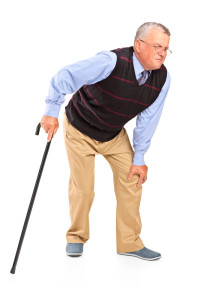Introduction
Low back pain, also often called “lower back pain” is a very common clinical entity. While in a younger age group back pain occurs in about 20 to 30% of the population, in persons above 60 years of age 50% will suffer from recurrent back pain.
90% of of acute low back pain will settle on its own within 6 weeks and within one year about 97% will settle (Ref. 1). Only about 3 % of all back pains need herniated disc surgery, yet everybody constantly talks about these cases or the threat of such a case. Perhaps this is so, because it is “more glamorous”, more “newsworthy” or more tangible. The truth though is that most of the time there is no real cause found or only non specific degenerative changes can be identified.
Nevertheless low back pain has an enormous impact on employers, on patients and on society as a whole because of the prolonged time loss from work.
Degenerative changes in back with age
Not infrequently in the older than 50 year population, when degenerative changes of the lower back play a more important role, work modifications or even retraining is needed to accommodate the injured person in the work place again. Union considerations, seniority issues and employer/employee relationship problems can complicate return to work efforts. However, many work places have made changes since the 1990’s allowing injured workers to return to modified work situations where they do not have to lift as heavy or repetitively as before their back injury until a point when their back problems have completely resolved.
Other ways of modifying risks from prolonged sitting is to allow the worker to have a back rest that is tilted backwards: http://www.askdrray.com/avoiding-back-pain-by-relaxed-sitting/
References
1. ABC of rheumatology, second edition, edited by Michael L. Snaith , M.D., BMJ Books, 1999.
2. The Merck Manual, 7th edition, by M. H. Beers et al., Whitehouse Station, N.J., 1999. Chapter 52.
3. The Merck Manual, 7th edition, by M. H. Beers et al., Whitehouse Station, N.J., 1999. Chapter 275,p.2429.
4. HA King Orthop Clin North Am 1988 Apr;19(2):247-255.
5. HA King Orthop Clin North Am 1999 Jul;30(3):467-474, ix.
6. The Merck Manual, 7th edition, by M. H. Beers et al., Whitehouse Station, N.J., 1999. Chapter 59.
7. JA Smith Orthop Clin North Am Jul 1999; 30(3): 487-499.
8. The Merck Manual, 7th edition, by M. H. Beers et al., Whitehouse Station, N.J., 1999. Chapter 56, p. 469.
9. Wheeless’ Textbook of Orthopaedics: http://www.wheelessonline.com/ortho/arthritis
10. Goldman: Cecil Textbook of Medicine, 21st ed.(©2000)W.B.Saunders
11. Ferri: Ferri’s Clinical Advisor: Instant Diagnosis and Treatment, 2004 ed., Copyright © 2004 Mosby, Inc.
12. Rakel: Conn’s Current Therapy 2004, 56th ed., Copyright © 2004 Elsevier







